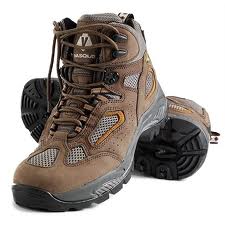 Hiking in the autumn can be an exhilarating experience. The leaves are brilliant yellows, oranges and reds. There’s a cool nip in the air. And the trail just beckons you onward. But most people don’t think about the stress and strain on their feet and ankles during a hike. While it may be fun taking a long walk on uneven terrain, it may not seem so fun later if you have foot and ankle pain. Therefore, you need to make the right preparations before you set out on the trail.
Hiking in the autumn can be an exhilarating experience. The leaves are brilliant yellows, oranges and reds. There’s a cool nip in the air. And the trail just beckons you onward. But most people don’t think about the stress and strain on their feet and ankles during a hike. While it may be fun taking a long walk on uneven terrain, it may not seem so fun later if you have foot and ankle pain. Therefore, you need to make the right preparations before you set out on the trail.
To make your hiking experience more enjoyable, follow these tips:
Keep Your Feet in Good Condition
In order to prevent foot pain in the first place, you should take care of your feet.
- Keep your toenails cut short and square to prevent them from cutting into your toes on either side.
- Dry your feet well when they get wet before putting your shoes and socks on.
- Get treatment ahead of time for any foot conditions, such as calluses, corns, bunions or hammertoe.
- If you experience frequent pain in your feet, ankles, knees, hips or lower back, see a podiatrist to determine if you have a biomechanical issue affecting your gait cycle. If you do have a problem, you may need a custom orthotic, like the ezWalker® Performance Insole. The ezWalker® insole is designed to guide your feet into a proper biomechanical alignment. Improper foot biomechanics can lead to conditions like plantar fasciitis, metatarsalgia and Morton’s neuroma. But proactive use of the ezWalker® Performance Insole can help prevent this pain in the first place.
Wear the Right Shoes and Socks
When hiking, you should wear top-quality, well-insulated hiking boots. These boots will provide you with proper ankle support while reducing muscle and tendon fatigue and your risk of injury.
When shopping for hiking boots, remember these tips: 
- If you’re a light or occasional day hiker, you may want a lighter weight hiking boot.
- Think about where you plan to go hiking, thicker soles are designed for harder terrain.
- If you live in a warmer climate or tend to sweat a lot, you will need a boot that is made of breathable materials.
- If you live in wet climates or will be hiking through streams, you will need a boot that is waterproof.
- If you’re a serious hiker, choose a boot that comes up higher on your ankle for better support.
- If you’re a hard-core backpacker, stiffer boots are better.
- Try on your boots with the socks you plan to wear when hiking. Socks can affect how the boots will fit. Also, socks can make the difference between a comfortable hike and a hike that results in blisters, fungal infections or frostbite. Moisture-wicking socks, like the Thorlo brand, will help to keep your feet dry by pulling moisture away from your skin. Wool socks will keep your feet warm, absorb moisture, and make your boots more comfortable. You may want to wear two layers of socks with a synthetic sock as the first layer and a wool sock as the second layer.
- Match the shape of the boot to the shape of your foot. If you have a wide foot, buy a wider boot.
- Make sure you get a good fit. Have both of your feet measured. If you have one foot that is larger than the other, buy boots in the size for your larger foot. Try on hiking boots toward the end of day when your feet tend to be larger. If you will be carrying a backpack while hiking, you should try your boots on with the extra weight on your back, so you can make sure your boots still fit when your feet spread out due to the backpack weight.
- Try on both boots in the store and walk around to make sure they feel comfortable.
Pay Attention to Your Body
To keep your hike from turning into a miserable time, you should always ease into your hiking adventures.
- Always stretch before your hike in order to warm up your foot, ankle and leg muscles to prevent injuries.
- Start out taking shorter hikes on less difficult terrain and gradually add more miles and tougher terrain.
- If you experience pain, you should stop walking and tend to the sore spot immediately. If friction is causing the sore spot, then determine what is causing it and fix it to prevent further rubbing. Otherwise, a blister may result.
- If your feet or ankles begin to hurt while hiking, take a break and rest them. Don’t continue hiking and risk getting a more serious injury.
- If you injure your feet or ankles while hiking, visit your doctor as soon as possible for treatment.
By following these tips, your hiking experience should be a pleasurable one, allowing you to enjoy the beauty of the changing season.
For more information on the ezWalker® Performance Insole, visit our website. These insoles are custom made to your individual feet, providing you with comfort and pain relief with every step you make. Order your pair of ezWalkers today!
ezWalker® insoles make your hiking boots feel like they walk for you. Remember … when your feet feel good, you feel good.


